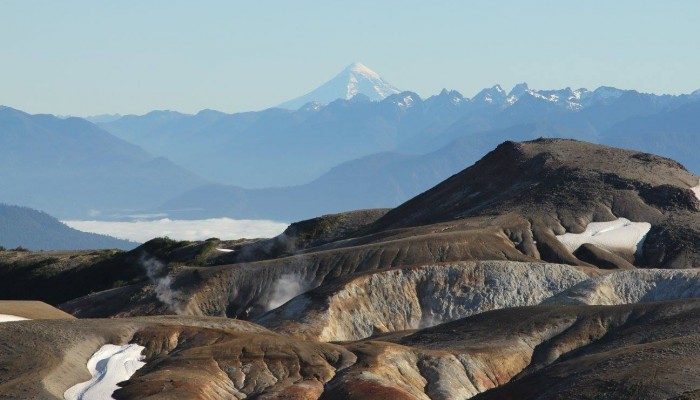
There is no escaping the fact that one of the perks of being an Earth scientist is the opportunity to visit incredible places while on field work. There is also no doubt that, geologist or not, walking on an active volcano is awe inspiring. Maybe you’ve had the experience of doing so yourself (if so, share your story with us in the comments section, we’d love to hear from you!), but if you haven’t then perhaps this post by Fabian Wadsworth, a volcanology PhD student at the Ludwig-Maximillian Universitat of Munich, Germany and part of the VUELCO project, might give you a feel for what it is like. In the post, Fabian describes his experience of journeying into the Cordon Caulle volcano, in Chile. A regular hiker of the German Alps, Fabian described the difference between climbing the impressive, but well-established trails of the Bavarian mountains to his trip to Chile: “a volcano, is dynamic on a large scale and provides little comfort at all. Hiking in active volcanic landscapes is, for me, more vivid and awakening for this reason.”
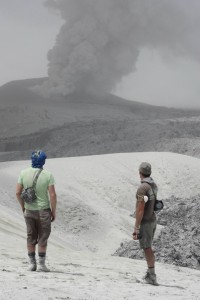
Ian Schipper with Jon Castro watching the mouth of the volcano churning out volcanic ash. Image Credit: Dr. Hugh Tuffen
Dr. Hugh Tuffen, Dr. Ian Schipper and Prof. Jon Castro are volcanologists who study how magmas move, flow and explode on their way up to and over the Earth’s surface. They invited me to join them to Cordon Caulle in January 2014, just two years after it stopped erupting explosively in 2012. This team of researchers had been there in 2011 and in 2012 when it was most vigorously exploding and this post combines photographic reflections on their experience and some from my trip to give you a view of this place and the hike that led us into the volcano’s mouth.
This volcano is unique. It is a type of volcano that produces vast quantities of volcanic glass: obsidian. As well as erupting a huge volcanic cloud, typical of many eruptions, it slowly pushed out a dark tongue of obsidian that was hot enough to squeeze at glacial rates down and away from the source. This kind of eruption is rare and Cordon Caulle is the only time in history that such a phenomenon has been witnessed and studied. Scientists are working to understand how the region can be blanketed by volcanic ash – the result of massive explosions – while this seemingly gentle tongue is pushed out at the same time. In this way, obsidian is one of the most interesting materials to volcanologists and it draws us from all over the world to hike in these wonder-places.
From Puerto Monnt we travelled the 125 km northeast deep into the Andes. The hike to the volcano begins with a long journey through forest up to the highland plateaus. In 2012 this forested land was densely covered in ash from the volcano, Hugh told me, but by 2014 had fully recovered its lush green. From the plateau, the Andes unfold before you and make the many hours hiking feel insignificant. We carried our equipment as well as water, food and sleeping gear ready for a week or more spent in the shadow of the lava. In 2012, the noise of the eruption was intense and could be heard for kilometres around. By 2014-2015, all was quiet except for the buzzing of horseflies and the occasional creek from the heavy glass lava that still crumbled its way over the sand.
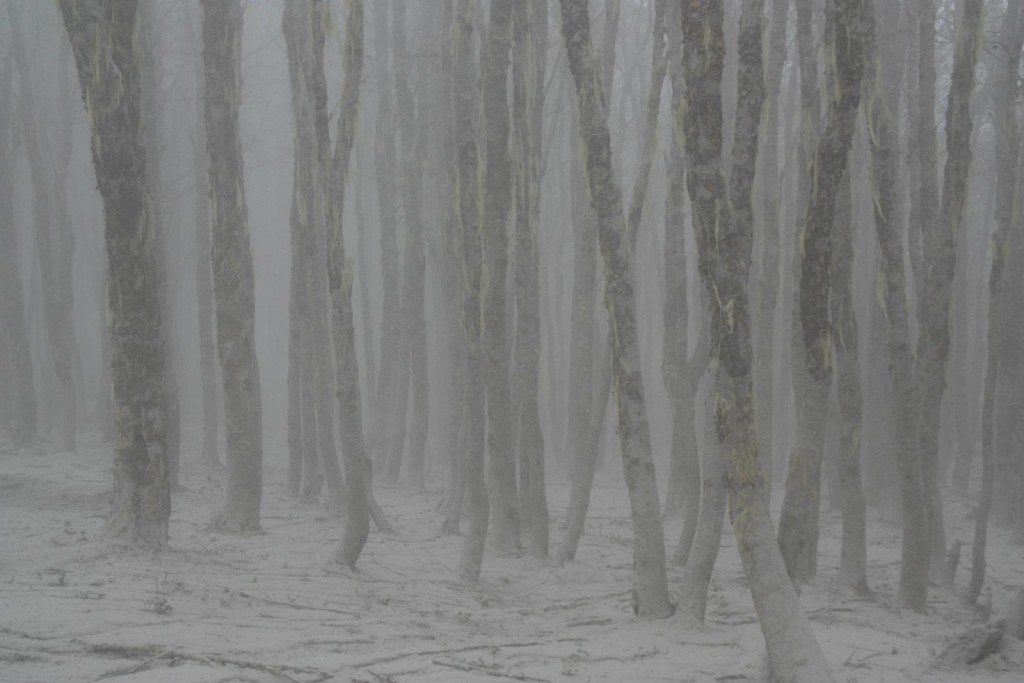
The forest land on the hike up in 2012. Hugh remembers the ash filling his hair and covering everything. Image Credit: Dr. Hugh Tuffen
All around are the dunes of the highland plateaus, ribbed with rainwater gullies and patches of ice, which quench the thirst of hardworking volcanologists.
Walking from site to site is hard because the ash-laden sand is soft and sometimes you sink deep. Boots fill with pebble-sized volcanic shards that litter the ground from the last eruption. The distances are also deceptive. The lava, this slow-moving lava flow of glass, is almost forty meters high and many kilometres wide. We made basecamp at one end of the lava and each day hiked to places of interest, sometimes for hours, around the plateaus.
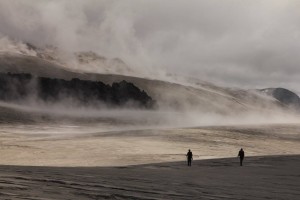
Hugh returned in 2015 yet again with Mike James and student Nathan Magnall and walked between slivers of cloud and tongues of glassy lava. Image Credit: Dr. Hugh Tuffen
Starting before dawn, we took one day to set off for a place no one has seen before. We wanted to climb into the mouth of the volcano; into the vent from where the lava was being pushed out back in 2011 and 2012. No one has been into such a place before – the source of obsidian – and we thought that some of the observations we could make would hold a key to the puzzle of these eruptions. We hiked for hours around the great lava flow and to the back side of the vent area. We put on our gas masks to filter some of the still-circulating toxic volcanic gases and particles and we pulled our hats down against the fierce sun. We climbed the cone to the top and peered down into the vent area itself. From that vantage point we circled down the cone’s rim and into the vent proper. From there, gazing back up at the inner walls of the volcano, Hugh, Jon and Ian remembered watched this area explode and writhe just a few years before at the height of eruption. With an uneasy feeling, we set about learning what we could from the rocks and glass at the source of obsidian on our Earth’s surface.
Snatching our hard-won science, we returned to camp only after dark, hungry and thirsty and shared the small celebratory whisky ration we had brought with us. This day, inside the volcano, will remain among the most vivid in my life. And now, back in Munich, I can readily recall the sulfur smell and shine of the glass in that place.
Hugh, Ian and Jon will no doubt continue to return to this enigmatic place to learn more each year and will listen out for the next time obsidian erupts. Nathan Magnall has recently embarked on a PhD project focused on unveiling more of the mysteries of this place and Tuppence Stone, Toby Strong and Christiaan Munoz Salas, who joined Hugh in January 2015, filmed for the forthcoming BBC2 Patagonia series. You can also watch Hugh talk about Cordon Caulle in the video below too – skip to minute 13:00.
The poetry of the place should surely draw people from all disciplines to walk on those new stones – something I emphatically encourage you to do.
By Fabian Wadsworth, PhD Student Ludwig-Maximillian Universitat.
This post was originally posted on the Yetirama Blog. For the original post, please follow this link. We are very thankful to Dr. Hugh Tuffen for the use of his images in this post.

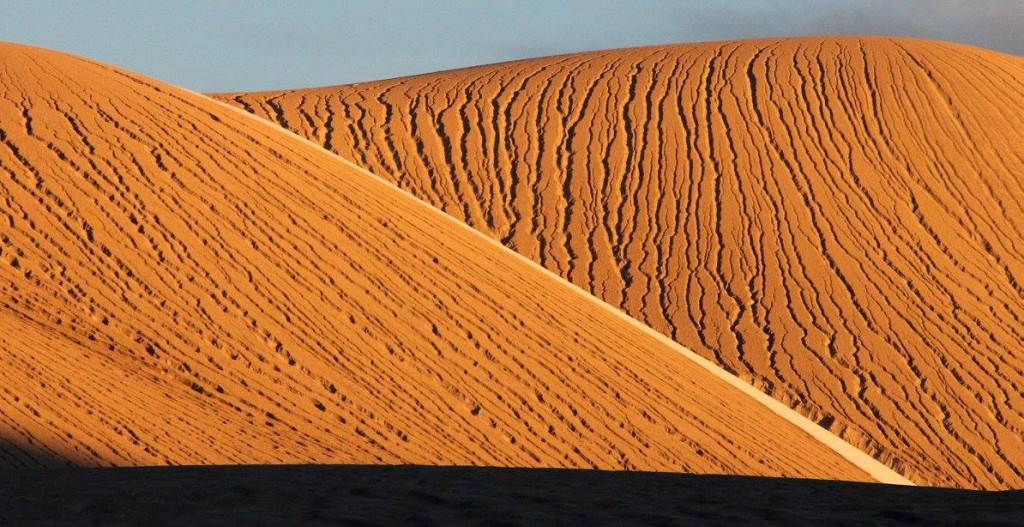
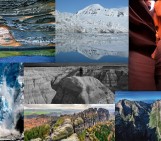
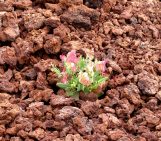
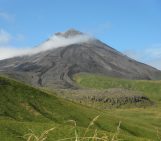
Pingback: US Volcano Monitoring May Get an Overhaul | KrazyWorksKrazyWorks